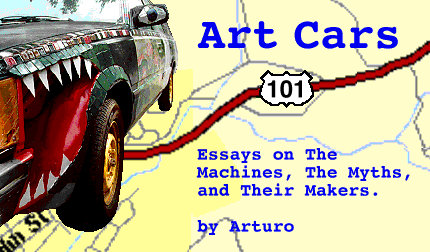

Carnival CarsA Prelude to a Parade
I have heard that parades make other art cars feel the same way. For an art car, it just doesn't get any better than this. But why? Why does the parade make an art car so happy? To answer this question, we'll have to pop the hood and see what drives your typical art car. And I don't mean a four-cylinder, 1800-cc engine. I am talking about an art car's hopes, dreams, and aspirations. The best tool for exposing these things, therefore, is not a socket-wrench set, but a nice basic introductory psychology text. In the terminology of psychologist Abraham Maslow, the moments of extreme fulfillment that an art car feels when participating in a parade would be called "peak experiences." For Maslow, peak experiences occur when an individual is living out his or her highest destiny: becoming the person that he or she was meant to be and self-actualizing. Because most art cars were meant to be festive vehicles, participating in festivals is one of their primary goals in life. Art cars want to celebrate. Created as a way of stepping outside the drab routines of daily life, they are holiday revelers at heart. Even when an art car parade is six months away, and there is not another art car in sight, most art cars are holding a party of one. Art cars are deeply rooted in the carnivalesque. As anyone who has ever succumbed to highway hypnosis can surely attest, the automobile has intoxicating powers, it breaks down both the oppositions of rational thought and the boundaries between individual objects in a blur of speed. Driving, as Jean Baudrillard describes it, produces a,"Triumph of forgetting over memory, an uncultivated, amnesic intoxication." Art has intoxicating properties of its own. With its capacity to defy the laws of gravity and perspective, art can lure the viewer into an irrational dream world. When these two forces are combined in the art car, a wild ride ensues.
Many art cars express a loosening of control, an opening up to the infinitude of nature's possibilities. While the very act of becoming an art car requires some lowered inhibitions, many cars take it one step further. They employ an alternative logic of random assemblage and caprice. Leo Whitebird's decorated mail truck provides a prime example of this way of thinking. Its only unifying theme is that it has no unifying theme. Toys, hardware, and sculpture project haphazardly from its roof and sides. Spray-painted lines meander aimlessly around its surfaces. This truck is drunk, and I myself find it hard not to feel a bit tipsy looking at it.
Other art cars seek to represent the sensual pleasure of intoxication with scintillating displays of color, motion, and light. Belinda is covered with a collage of buttons and beads. A pair of fans is mounted on her roof. Spinning in the wind, they set the whole array into motion. The theme of having fun dominates many of these vehicles, including the Bowling Car. Nine bowling-trophy statuettes throw their balls in orderly formation down the hood. On either side of the car, a bowling ball plows through seven pins. Because these items are glued in place, the lanes of the Bowling Car are open twenty-four hours a day, seven days a week, in an obsessive pursuit of fun. The art car parade is a form of Dionysian revelry, an orgy of sorts where art cars can indulge themselves in a shared passion. It is a place where slightly out of control automobiles can make fools of themselves among their friends. Art cars are, after all, fools, just like the cartoon characters that so often adorn them. In the cartoon world on Marti's van, the laws of nature are indefinitely suspended. Her dogs walk on two legs and wear clothes. Cartoon characters are also naughty. From Mickey Mouse playing "Turkey in the Straw" on a hippopotamus' teeth, to Wiley Coyote's attempts to detonate the Road Runner, cartoon characters have always been more than a little bit mischievous. These animated animals, like car artists, habitually disrespect the rules and regulations of society. They are perfect subjects for car art. Other sorts of transgressive themes are also common on art cars, such as travesty (i.e. placing things where they do not ordinarily belong). As a recreational vehicle, the Universe Hearse flies in the face of the grave solemnity with which hearses are usually associated. Likewise, Belinda has a snarling boar's head mounted above her front bumper, ready to charge at the reactionary forces of society. As a festival where transgression reigns supreme, the art car parade is a carnival. It inverts the standard order of things. Whereas undecorated automobiles dominate the streets 364 days out of the year, on the day of the parade, art cars rule. | ||
Art Cars 101 Table of ContentsSend Arturo e-mail in care of rowan003@gold.tc.umn.edu |
